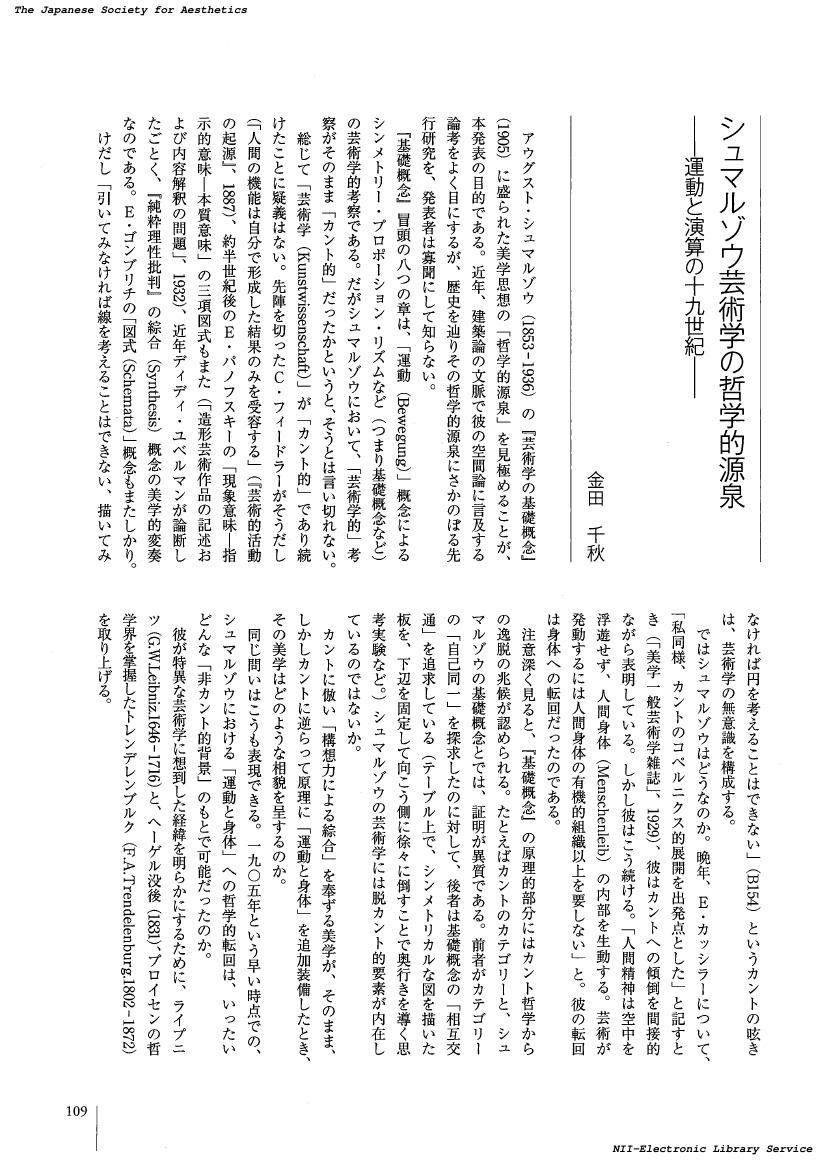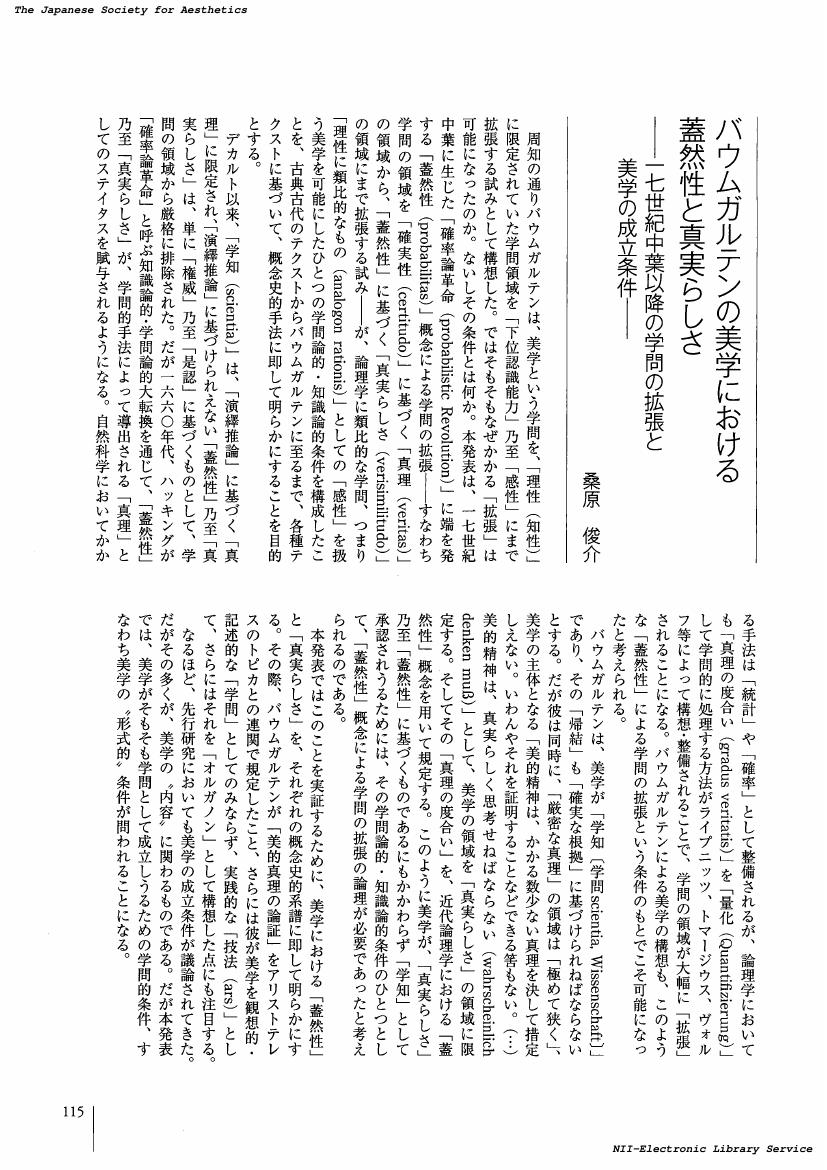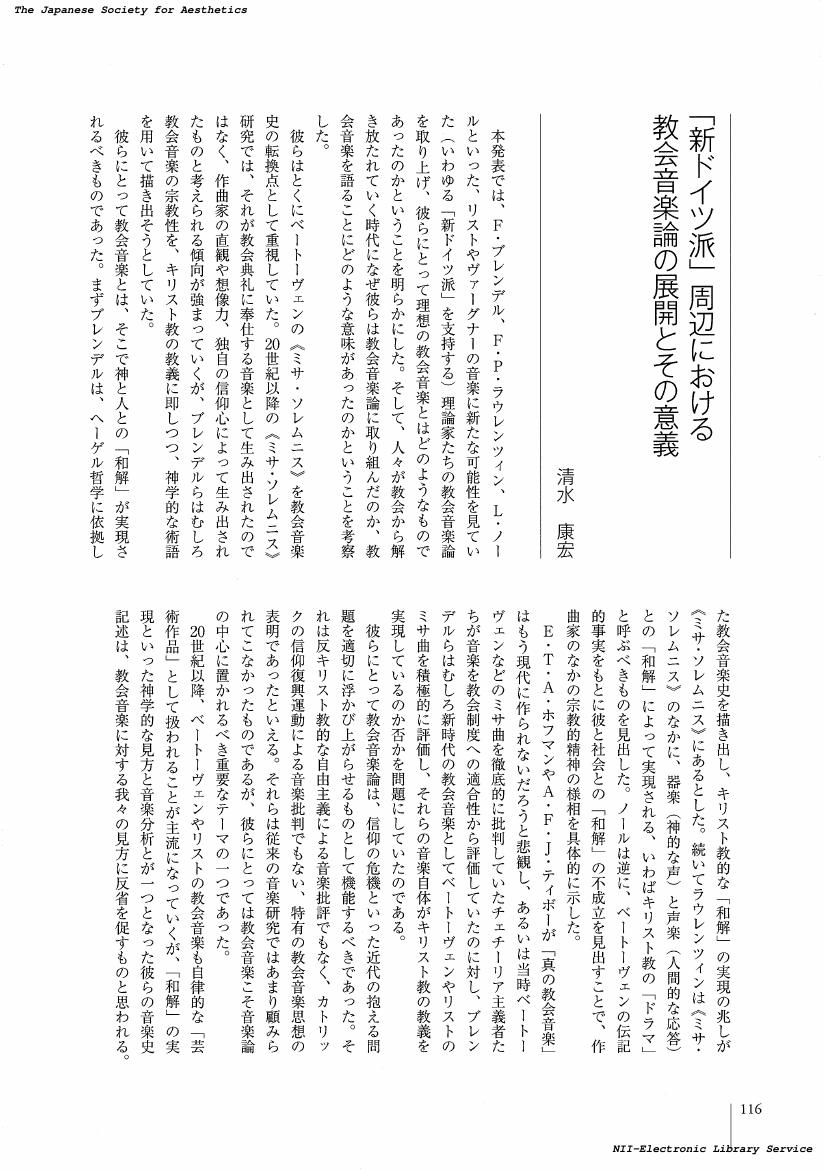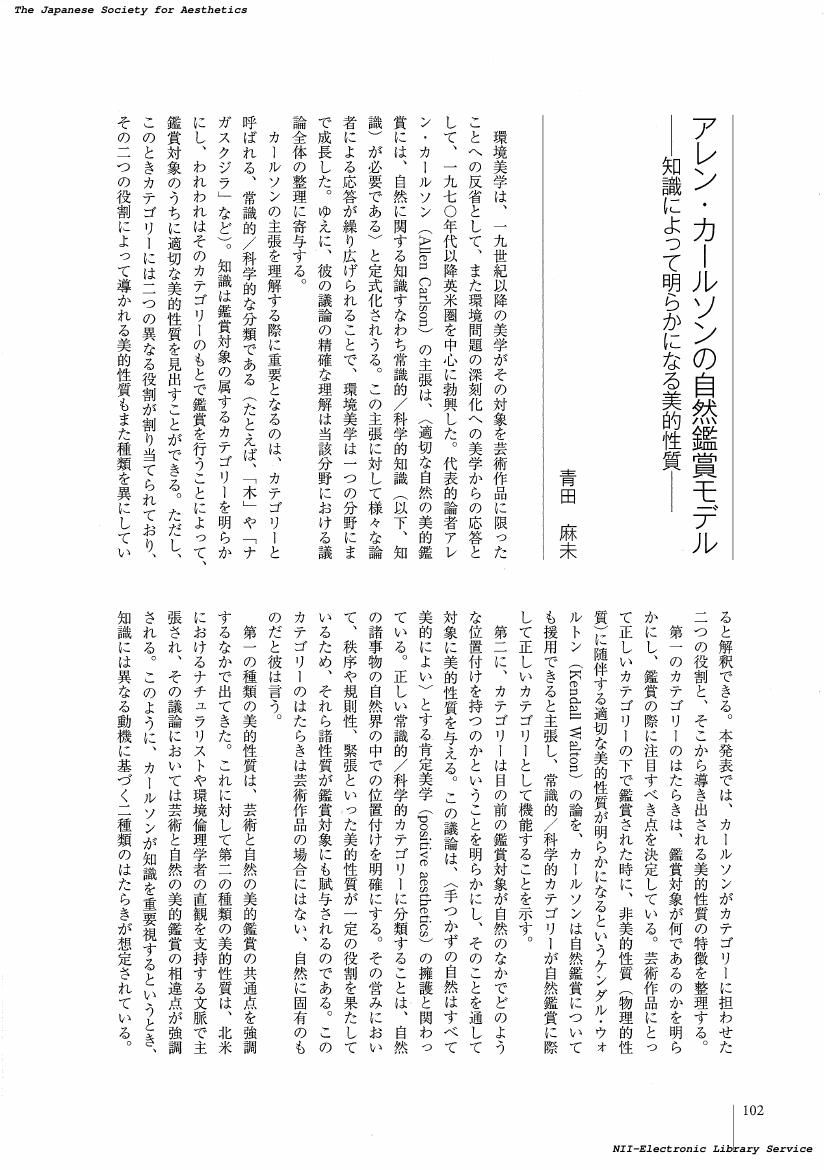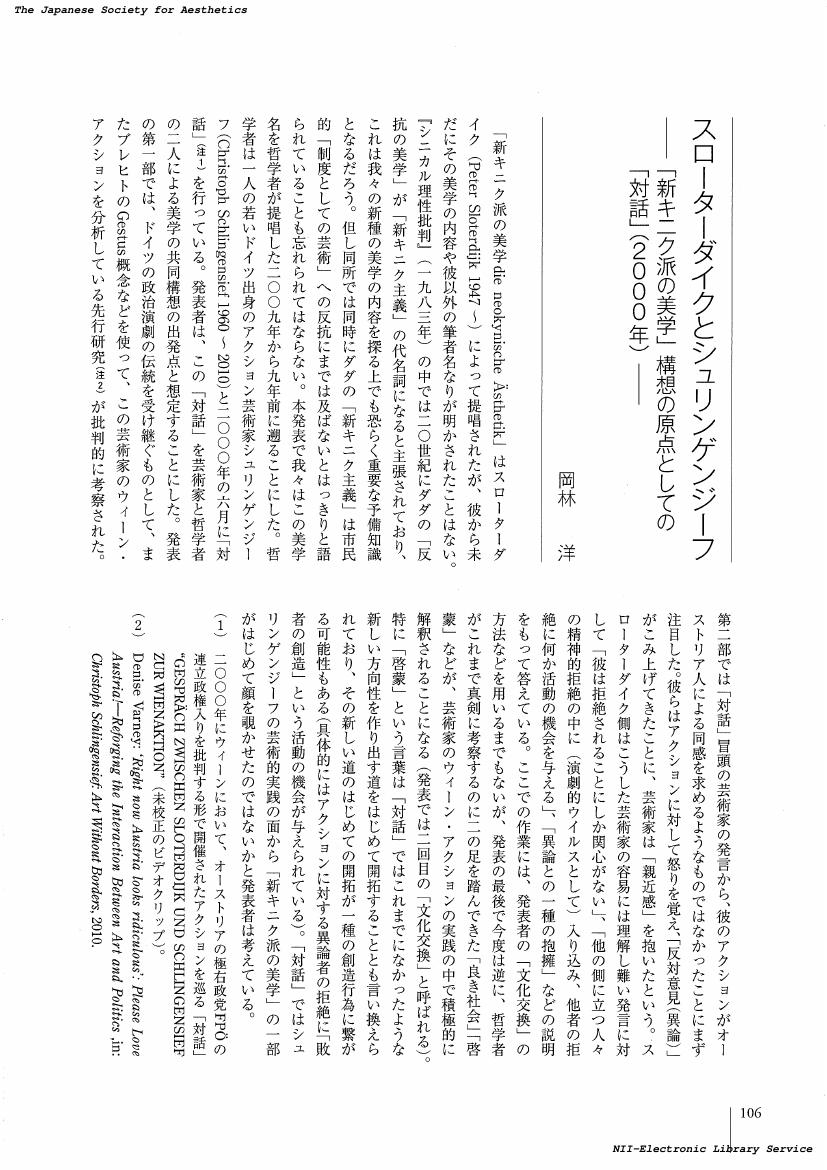- 著者
- 秦 明子
- 出版者
- 美学会
- 雑誌
- 美学 (ISSN:05200962)
- 巻号頁・発行日
- vol.65, no.2, pp.124, 2014-12-31 (Released:2017-05-22)
- 著者
- 府川 純一郎
- 出版者
- 美学会
- 雑誌
- 美学 (ISSN:05200962)
- 巻号頁・発行日
- vol.65, no.2, pp.125, 2014-12-31 (Released:2017-05-22)
- 著者
- 藤田 明史
- 出版者
- 美学会
- 雑誌
- 美学 (ISSN:05200962)
- 巻号頁・発行日
- vol.65, no.2, pp.126, 2014-12-31 (Released:2017-05-22)
1 0 0 0 OA コンディヤック『人間認識起源論』における分析的方法(第六十五回美学会全国大会発表要旨)
- 著者
- 小田 昇平
- 出版者
- 美学会
- 雑誌
- 美学 (ISSN:05200962)
- 巻号頁・発行日
- vol.65, no.2, pp.108, 2014-12-31 (Released:2017-05-22)
- 著者
- 金田 千秋
- 出版者
- 美学会
- 雑誌
- 美学 (ISSN:05200962)
- 巻号頁・発行日
- vol.65, no.2, pp.109, 2014-12-31 (Released:2017-05-22)
- 著者
- 河合 大介
- 出版者
- 美学会
- 雑誌
- 美学 (ISSN:05200962)
- 巻号頁・発行日
- vol.65, no.2, pp.110, 2014-12-31 (Released:2017-05-22)
- 著者
- 河上 春香
- 出版者
- 美学会
- 雑誌
- 美学 (ISSN:05200962)
- 巻号頁・発行日
- vol.65, no.2, pp.111, 2014-12-31 (Released:2017-05-22)
1 0 0 0 OA 古典的物語映画における三度の反復の効果(第六十五回美学会全国大会発表要旨)
- 著者
- 木村 建哉
- 出版者
- 美学会
- 雑誌
- 美学 (ISSN:05200962)
- 巻号頁・発行日
- vol.65, no.2, pp.112, 2014-12-31 (Released:2017-05-22)
1 0 0 0 OA レンブラント「トビト記連作」における盲目性の表象(第六十五回美学会全国大会発表要旨)
- 著者
- 国清 景子
- 出版者
- 美学会
- 雑誌
- 美学 (ISSN:05200962)
- 巻号頁・発行日
- vol.65, no.2, pp.113, 2014-12-31 (Released:2017-05-22)
- 著者
- 栗原 詩子
- 出版者
- 美学会
- 雑誌
- 美学 (ISSN:05200962)
- 巻号頁・発行日
- vol.65, no.2, pp.114, 2014-12-31 (Released:2017-05-22)
- 著者
- 桑原 俊介
- 出版者
- 美学会
- 雑誌
- 美学 (ISSN:05200962)
- 巻号頁・発行日
- vol.65, no.2, pp.115, 2014-12-31 (Released:2017-05-22)
1 0 0 0 OA 「新ドイツ派」周辺における教会音楽論の展開とその意義(第六十五回美学会全国大会発表要旨)
- 著者
- 清水 康宏
- 出版者
- 美学会
- 雑誌
- 美学 (ISSN:05200962)
- 巻号頁・発行日
- vol.65, no.2, pp.116, 2014-12-31 (Released:2017-05-22)
1 0 0 0 OA マルセル・デュシャンにおけるレディ・メイド概念の変遷
- 著者
- 岩見 亮
- 出版者
- 美学会
- 雑誌
- 美学 (ISSN:05200962)
- 巻号頁・発行日
- vol.65, no.2, pp.49-60, 2014-12-31 (Released:2017-05-22)
Marcel Duchamp's Ready-made has long been considered a pioneer in the anti-visual, anti-aesthetic and conceptual arts, which decisively influenced the historical development of contemporary American art after abstract expressionism. Surveying the discourse of Duchamp, however, we see that he had changed his concept of the ready-made depending on art historical conditions. This paper aims to first point out that the ready-made, anti-aesthetic and conceptual in nature, in fact, emerged and came to the fore simultaneously with the very arts which had been considered to be influenced by the ready-made; and second, to elucidate the significant role Clement Greenberg's formalist criticism played, which was already distinguished at that time, in the formation of the concept of the ready-made. It is thought that during the 1960's Duchamp intentionally contrasted his idea of the ready-made and Greensburg's American modernism, a binary which, to this day, still functions as the theoretical basis for the understanding of the history of contemporary art.
1 0 0 0 OA 「指標的類似」、「類像的類似」から考察するシュルレアリスム写真とマン・レイのレイヨグラフ
- 著者
- 木水 千里
- 出版者
- 美学会
- 雑誌
- 美学 (ISSN:05200962)
- 巻号頁・発行日
- vol.65, no.2, pp.61-72, 2014-12-31 (Released:2017-05-22)
La photographie est un indice. Apres la presentation de ce concept sur la base de la semiotique de Pierce par Rosalind Krauss dans son article <<Notes on the Index>>, ce concept a tout a fait fini par penetrer dans le champ photographique et artistique. Cependant, la photographie n'est-elle qu'un indice ? Notre etude a pour but d'examiner cette question avec l'aide des deux aspects de la ressemblance chez Pierce indiques par Dominique Chateau : il existe la ressemblance indicielle et la ressemblance iconique dans la photographie. A travers cette theorie, nous confirmons que dans l'article <<Photographie et surrealisme>>, ou il est essentiellement question de l'indicialite de la photographie, cette theoricienne presente inconsciemment, en tant que caracteristique des photographies surrealistes, l'iconicite de la photographie. Et puis, on analyse a nouveau la rayographie de Man Ray traitee comme le modele d'indice. Cette tentative de comprendre que la photographie n'est plus seulement considered en tant qu'indice, mais en tant qu'icone, nous permettra de discuter de la facon globale divers interpretations sur la photographie, de mettre en lumiere des idees artistiques qui les produisent.
1 0 0 0 OA 日本国際美術展(東京ビエンナーレ)再考 : 戦後日本における国際美術展の志向性
- 著者
- 山下 晃平
- 出版者
- 美学会
- 雑誌
- 美学 (ISSN:05200962)
- 巻号頁・発行日
- vol.65, no.2, pp.85-96, 2014-12-31 (Released:2017-05-22)
This paper takes up "The Japan International Art Exhibition (Tokyo Biennale)", the first international art exhibition in Japan after World War II. In 1952, the first exhibition was held under the auspices of the Mainichi Newspaper Company until 1990, the 18th and last one. During this time, the exhibition was unavoidably changed by the movements of the times, but we still haven't researched the exhibitions as a whole. In this paper, I have collected numerous articles about "The Japan International Art Exhibition" and have inspected the intentions. As a result, we can find that the intentions shifted from the "across-the-board" structure in the situation of "Japan against the World" to "avantgardism". In being avant-garde, on the other hand, the exhibition had the condition of a conservative bias against the West's sense of values or systematized "Art". With the end of the binomial opposition of "Japan and the World", "simultaneity" was then pursued, but the "Japanese originality" in the "simultaneity" wasn't pursued carefully enough. Japan has continually been involved with the problem of institutionalizing "Art" and the context peculiar to Japan since modern times. After WW II it was again expressed in this international exhibition. Thus, "The Japan International Art Exhibition" formed an important stage for criticism in Japan after WW II and has always relativized the position of "Japan".
- 著者
- 青田 麻未
- 出版者
- 美学会
- 雑誌
- 美学 (ISSN:05200962)
- 巻号頁・発行日
- vol.65, no.2, pp.102, 2014-12-31 (Released:2017-05-22)
- 著者
- 荒木 文果
- 出版者
- 美学会
- 雑誌
- 美学 (ISSN:05200962)
- 巻号頁・発行日
- vol.65, no.2, pp.103, 2014-12-31 (Released:2017-05-22)
- 著者
- 江本 紫織
- 出版者
- 美学会
- 雑誌
- 美学 (ISSN:05200962)
- 巻号頁・発行日
- vol.65, no.2, pp.104, 2014-12-31 (Released:2017-05-22)
1 0 0 0 OA 見立ての詩学 : 擬えと転用の弁証法(第六十五回美学会全国大会発表要旨)
- 著者
- 大石 昌史
- 出版者
- 美学会
- 雑誌
- 美学 (ISSN:05200962)
- 巻号頁・発行日
- vol.65, no.2, pp.105, 2014-12-31 (Released:2017-05-22)
- 著者
- 岡林 洋
- 出版者
- 美学会
- 雑誌
- 美学 (ISSN:05200962)
- 巻号頁・発行日
- vol.65, no.2, pp.106, 2014-12-31 (Released:2017-05-22)




